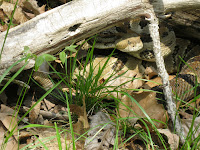 |
| Lone Star Tick- Wikimedia |
“The whole issue of insect and tick survival in the winter and predicting it is much more complex than we might think. That’s because a very cold winter doesn’t always guarantee that insect populations will be low once warm weather begins," he said. "Cold weather causes insects to go dormant, and bugs that burrow into the soil or have other protection tend to survive. Continuous cold, in some cases, actually is better for insect survival. Insects that leave dormancy and become active during warm weather often don’t find food needed to survive."Driving the lane along our glade at Bull Creek, I came across a 30" timber rattlesnake which we had apparently driven over the day before. It had been taking advantage of the warm weather to head out hunting. Basking in the sun would be common but I was surprised that it had roamed this early from the south facing rocky shelf rocks that its family normally calls home.
 |
| Find the rattle- click to enlarge |
Another sign of early spring was the appearance of a black vulture on the corral fence of our old deserted barn. They had nested in a stall there last year, entering through some missing boards in the wall. We had the privilege of watching their chicks grow up into fine adults (picture).
Allaboutbirds says this about black vulture nesting habits:
"Instead of building a nest, the Black Vulture lays its eggs on the bare ground of the chosen nest site. Parents incubate the young equally. The Black Vulture lays its eggs in isolated locations with little human disturbance. They find a dark recess in a cave, abandoned building, thicket, pile of rocks, or in a hollow log or tree. A pair of Black Vultures may assure themselves of the site’s isolation by perching nearby for a period of weeks before egg-laying."
 |
| Vulture chicks now grown |
Early or not, ticks or no, you gotta love spring.